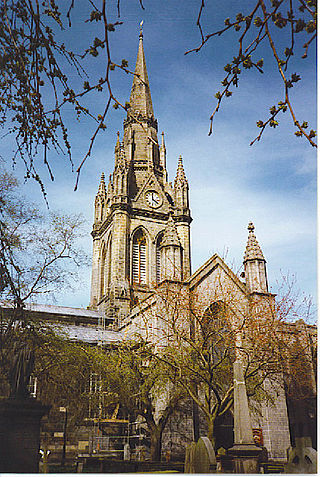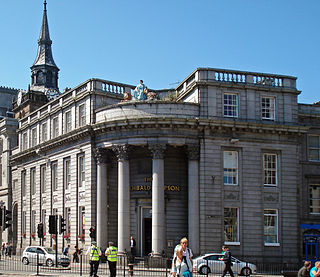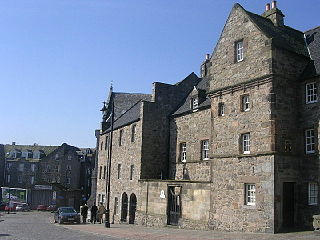
Aberdeen is a city located in Harford County, Maryland, United States, 26 miles (42 km) northeast of Baltimore. The population was 16,254 at the 2020 United States Census. Aberdeen is the largest municipality in Harford County.

The Alford Valley Railway is a 2 ft narrow gauge railway in the Howe of Alford, Aberdeenshire, Scotland. It is located at what used to be the terminus of the passenger and goods Alford Valley Railway which connected with the Great North of Scotland Railway main line at Kintore.

Turriff is a town and civil parish in Aberdeenshire in Scotland. It lies on the River Deveron, about 166 feet (51 m) above sea level, and has a population of 5,708. In everyday speech it is often referred to by its Scots name Turra, which is derived from the Scottish Gaelic pronunciation.

The Ba' Game is a version of medieval football played in Scotland, primarily in Orkney and the Scottish Borders, around Christmas and New Year.

Aberdeenshire or the County of Aberdeen is a historic county and registration county of Scotland. The area of the county, excluding the Aberdeen City council area itself, is also a lieutenancy area. The county borders Kincardineshire, Angus and Perthshire to the south, Inverness-shire and Banffshire to the west, and the North Sea to the north and east. It has a coast-line of 65 miles (105 km). The county gives its name to the modern Aberdeenshire council area, which covers a larger area than the historic county.

The Canongate is a street and associated district in central Edinburgh, the capital city of Scotland. The street forms the main eastern length of the Royal Mile while the district is the main eastern section of Edinburgh's Old Town.

A mercat cross is the Scots name for the market cross found frequently in Scottish cities, towns and villages where historically the right to hold a regular market or fair was granted by the monarch, a bishop or a baron. It therefore served a secular purpose as a symbol of authority, and was an indication of a burgh's relative prosperity. Historically, the term dates from the period before 1707, when the Kingdom of Scotland was an independent state, but it has been applied loosely to later structures built in the traditional architectural style of crosses or structures fulfilling the function of marking a settlement's focal point. Historical documents often refer simply to "the cross" of whichever town or village is mentioned. Today, there are around 126 known examples of extant crosses in Scotland, though the number rises if later imitations are added.

The Kirk of St Nicholas is a historic church located in the city centre of Aberdeen, Scotland. Up until the dissolution of the congregation on 31 December 2020, it was known as the "Kirk of St Nicholas Uniting". It is also known as "The Mither Kirk" of the city. As of 1 January 2021, the building falls under the care and maintenance of the General Trustees of the Church of Scotland.

Queen's Cross is an area in the West End of Aberdeen, Scotland. It is located just west of the main thoroughfare of Union Street and about 1.5 miles (2.4 km) from the geographical town centre at Mercat Cross.

Union Street is a major street and shopping thoroughfare in Aberdeen, Scotland. It is named after the Acts of Union 1800 with Ireland.

The architecture of Aberdeen, Scotland, is known for the use of granite as the principal construction material. The stone, which has been quarried in and around the city, has given Aberdeen the epithet The Granite City, or more romantically, and less commonly used, the Silver City, after the mica in the stone which sparkles in the sun.

Castlegate is a small area of Aberdeen, Scotland, located centrally at the east end of the city's main thoroughfare Union Street. Generally speaking, locals consider it to encompass the square at the end of Union Street where the Mercat Cross and Gallowgate are located.

Shiprow is a historic street in the heart of Aberdeen, Scotland, near the harbour. Formerly the Shiprow sloped upward more gradually than it does now, and it crossed Union Street in a depression between St Catherine's Hill on the west and Castle Street, once high uneven ground, on the east. That the Shiprow has been made up several feet can be seen by a house at the end of Exchequer Row, and it crossed Union Street and entered Broad Street at a lower level than the present.

Teesquay Millennium Footbridge is a footbridge crossing east-west over the River Tees between Stockton high street and Thornaby in Northern England. It is just east of Stockton town centre and in the town's namesake borough.

Parliament Square, Edinburgh, Scotland, is located off the High Street, part of the Royal Mile. The square is not a formal square, but consists of two sections surrounding St Giles Kirk on three sides: an L-shaped area to the east and south and another area on the west side of the church called West Parliament Square. The Edinburgh Mercat Cross is located on the east side of the square while an equestrian statue of Charles II of Scotland stands in front of the entrance to the Supreme Courts of Scotland adjoining Parliament House, on the west side. The Queensberry Memorial to the 5th Duke of Buccleuch, stands in West Parliament Square.

The Mercat Cross of Edinburgh is a market cross, the structure that marks the market square of the market town of Edinburgh. It stands in Parliament Square next to St Giles' Cathedral, facing the High Street in the Old Town of Edinburgh.

The Wellington Suspension Bridge is a suspension bridge crossing the River Dee from Ferryhill to Craiglug in Aberdeen, north east Scotland. Designed by Captain Samuel Brown and the Aberdeen City Architect John Smith, it was opened to pedestrians in November 1830 and to traffic in May 1831. The chain bridge was closed in 1984 to vehicles and then pedestrians in 2002, but was restored in 2006/07 and pedestrian use was re-instated in 2008.
Janet Wishart, was an accused witch from Aberdeen who became known as the Great Witch of Scotland. Wishart was an important figure in the great Scottish witchcraft panic of 1597 as her family were the focus of the trials in Aberdeen where 22 women and one man were found guilty of witchcraft.

Scott Sutherland was a Scottish sculptor, best known for the Commando Memorial in Spean Bridge. He was Head of Sculpture at Duncan of Jordanstone College of Art

New Aberdeen is a neighbourhood in Aberdeen, Scotland.

















